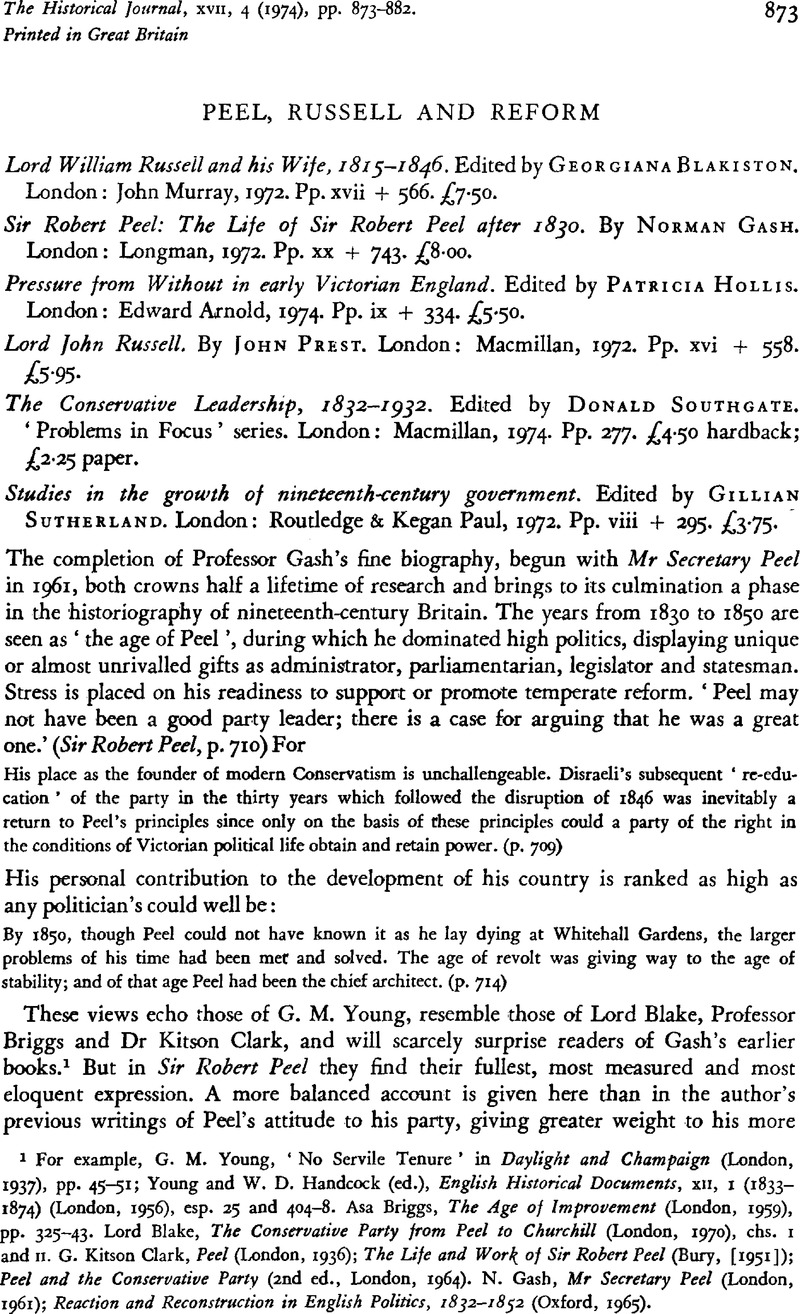Article contents
Peel, Russell and Reform
Published online by Cambridge University Press: 11 February 2009
Abstract

- Type
- Review Articles
- Information
- Copyright
- Copyright © Cambridge University Press 1974
References
1 For example, Young, G. M., ‘No Servile Tenure’ in Daylight and Champaign (London, 1937), pp. 45–51;Google ScholarYoung, and Handcock, W. D. (ed.), English Historical Documents, XII, 1 (1833–1874) (London, 1956), esp. 25 and 404–8.Google ScholarBriggs, Asa, The Age of Improvement (London, 1959), pp. 325–43.Google ScholarBlake, Lord, The Conservative Party from Peel to Churchill (London, 1970), chs. 1 and 11.Google ScholarClark, G. Kitson, Peel (London, 1936)Google Scholar; The Life and Work of Sir Robert Peel (Bury, [1951]);Google ScholarPeel and the Conservative Party (2nd ed., London, 1964)Google Scholar. Gash, N., Mr Secretary Peel (London, 1961);Google ScholarReaction and Reconstruction in English Politics, 1832—1852 (Oxford, 1965).Google Scholar
2 Young, ‘No Servile Tenure’ p. 48.
3 Kemp, B., ‘Reflections on the Repeal of the Corn Laws’, Victorian Studies, v (1962), 189–204Google Scholar. McCord, N., The Anti-Corn Law League (London, 1958).Google ScholarMoore, D. C., ‘The Corn Laws and High Farming’, Economic History Review, 2nd series, XVIII (1965), 544–61.CrossRefGoogle Scholar Cf. Gash's account in Sir Robert Peel, ch. xv, and Clark, Kitson, ‘The Repeal of the Corn Laws and the Politics of the Forties’, Economic History Review, 2nd series, IV (1951), 1–13.CrossRefGoogle Scholar
4 Gash, , Politics in the Age of Peel (London, 1953), esp. ch. 1.Google ScholarMoore, , ‘Concession or Cure: the Sociological Premises of the First Reform Act’, Historical Journal, ix (1966), 39–59.CrossRefGoogle ScholarCowling, M., 1867: Disraeli, Gladstone and Revolution (Cambridge, 1967).CrossRefGoogle ScholarJones, G. A., The Politics of Reform: 1884 (Cambridge, 1972).Google ScholarCooke, A. B. and Vincent, J. R., The Governing Passion (Brighton, 1974).Google Scholar
5 Clark, Kitson, ‘“Statesmen in Disguise’, Historical Journal, II (1959), 19–39.CrossRefGoogle ScholarMac-Donagh, O., ‘The Nineteenth-Century Revolution in Government: A Re-appraisal’, Historical Journal, I (1958), 52–67CrossRefGoogle Scholar. Cf. Hart, J., ‘Nineteenth-century Social Reform: A Tory Interpretation of History’, Past and Present, no. 31 (1965), pp. 39–61.CrossRefGoogle Scholar
6 Thomson, D., ‘Bias in Victorian History’, Cambridge Review, LXXVIII (9 03 1957), 481–2.Google Scholar
7 Moore, , ‘Concession or Cure’, esp. pp. 45–6;Google Scholar‘Political Morality in Mid-Nineteenth Century England: Concepts, Norms and Violations', Victorian Studies, XIII (1969), 5–36.Google ScholarThomas, W., ‘James Mill's Politics: The “Essay on Government” and the Movement for Reform’, Historical Journal, XII (1969), 149–84Google Scholar, and rhe subsequent controversy in vols. xiv and xv between Thomas and W. R. Carr.
8 This I take to be the message of the books already cited by Cowling, Jones, and Cooke and Vincent.
9 Gash, , Reaction and Reconstruction, p. 131.Google Scholar
10 Namier, L. B., Monarchy and the Party System (Oxford, 1952), pp. 7–8.Google Scholar
11 Kemp, , ‘Reflections on the Repeal of the Corn Laws’, esp. p. 204.Google Scholar
12 Moore, , ‘The Corn Laws and High Farming’, esp. pp. 559–61.Google Scholar
13 Stewart, R. M., The Politics of Protection (Cambridge, 1971).Google Scholar The reviewer in the Economist (9 Oct. 1971), pp. 62–3 made some comments on Conservative historiography which are relevant to my discussion.
14 Blake, , Conservative Party, esp. pp. 58–9, 50.Google Scholar
15 Butler, Lord, The Art of the Possible (Harmondsworth, 1973), p. 29.Google Scholar
16 Butler, D. and Freeman, J., British Political Facts, 1900–1963 (London, 1963), pp. 122–3.Google Scholar
17 Peel's, memorandum of 21 June 1846 in Memoirs by SirPeel, R., 11 (London, 1857), 295.Google Scholar
18 Jones, E. L., The Development of English Agriculture, 1815—1873 (London, 1968), p. 36.CrossRefGoogle Scholar
19 Radzinowicz, L., A History of English Criminal Law (4 vols. to date, London, 1948–1968). This and the next paragraph rely heavily on this work.Google Scholar
20 Briggs, , Age of Improvement, pp. 216–18.Google ScholarTobias, J. J., Crime and Industrial Society in the Nineteenth Century (London, 1967)Google Scholar seems still in the grip of the traditional interpretation so far as the role of Peel in law reform is concerned, and the Pelican edition of 1972 has not been modified to take account of the material in Radzinowicz' fourth volume.
21 Porter, G. R., The Progress of the Nation (London, 1851), p. 365. The table was of course derived by Porter from material in the Parliamentary Papers. The figures relate only to England and Wales.Google Scholar
Gatrell, V. A. C. and Hadden, T. B., ‘Criminal statistics and their interpretation’ in Wrigley, E. A. (ed.), Nineteenth-century society: Essays in the use of quantitative methods for the study of social data (Cambridge, 1972),Google Scholar validate the official returns and, though they are only peripherally concerned with the question of law reform, appear in n. 20, p. 428, to support my interpretation.
22 Quoted in The Opinions of the Right Hon. Sir Robert Peel, expressed in Parliament and in Public (2nd ed., London, 1850), p. 211,Google Scholar from the Commons debate of 26 Mar. 1834.
23 Mather, F. C., ‘The Government and the Chartists’, in Briggs, A. (ed.),Chartist Studies (London, 1959), pp. 372–405.Google Scholar
24 Gash, , Sir Robert Peel, p. 714;Google ScholarYoung and Handcock, English Historical Documents, XII (1), 25.Google Scholar
25 Pinney, T. (ed.), The Letters of T. B. Macaulay, II (Cambridge, 1974), 152.Google Scholar
26 Chadwick, W. O., The Victorian Church, I (London, 1966), 232–324;Google ScholarVincent, J., The Formation of the Liberal Party (London, 1966), esp. pp. 144–6.Google Scholar
27 On education, see, most recently, Alexander, J. and Paz, D. G., ‘The Treasury Grants, 1833–1839’, British Journal of Educational Studies, XXXII (1974), 78–92.CrossRefGoogle Scholar
28 Clark, G. Kitso, The Maying of Victorian England (London, 1962), p. 156.Google Scholar
29 Some related points are made in my article ‘Parliamentary Parties and the “Independent” Member, 1810–1860’ in Ideas and Institutions of Victorian Britain (ed. Robson, R.) (London, 1967), pp. 1–19,Google Scholar and in my review of Gash's Reaction and Reconstruction, Historical Journal, x (1967), 313–16.Google Scholar
- 10
- Cited by


